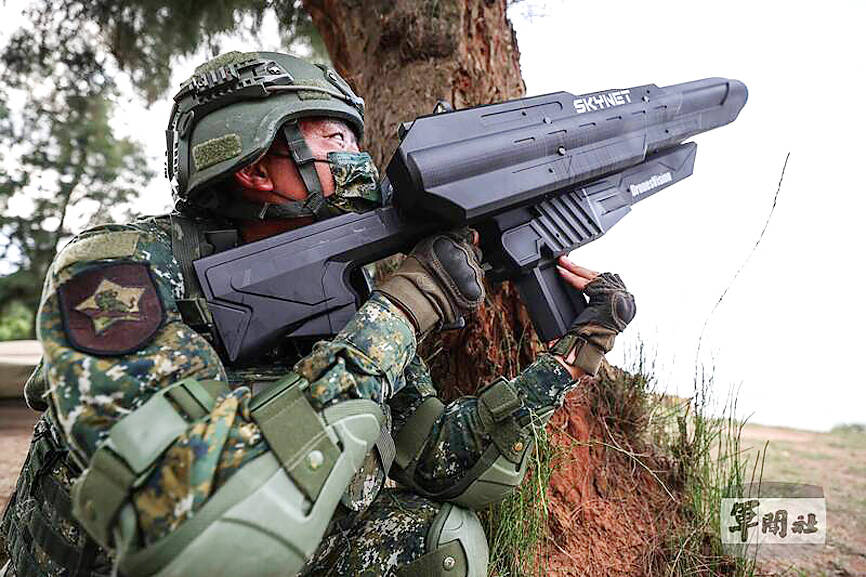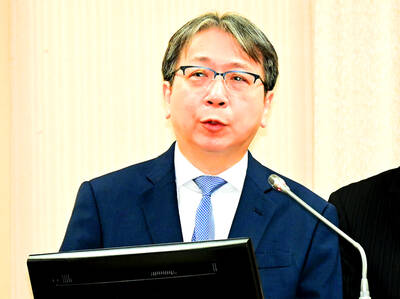The Ministry of National Defense has unveiled a proposed NT$9.67 billion (US$312.4 million) program to buy 635 lightweight anti-uncrewed aerial vehicle (UAV) systems capable of taking over, jamming and GPS data spoofing drones.
The draft proposal to purchase the systems over the next three years has not yet been finalized and must be approved by the legislature.
The systems must be capable of passively detecting more than 10 targets within a 4km zone with an imagery refresh rate of more than once per second and engaging drones operating on frequencies between 433 megahertz and 5.8 gigahertz to a range of 2km, the ministry said.

Photo courtesy of the Military News Agency
They must be small enough to be transported on light vehicles including tactical and civilian vehicles, as well as small boats, and require no more than 15 minutes to set up with one or two operators, it said.
The manufacturers must deliver a first batch of 242 systems to the military for testing within 180 days of being notified that it has been awarded a contract, and a second batch of 393 systems within 180 days of passing performance tests, it said.
Supplementary material attached to the notification showed that the program would provide 242 systems to the army, 213 systems to the navy, 72 systems to the air force and 108 systems to the Information, Communications and Electronic Force Command, it said.
Funding would be drawn from annual special budgets designated for next year, 2027 and 2028, the ministry said.
An expert speaking on condition of anonymity criticized aspects of the proposed counter-UAV program, saying the ministry might need to re-examine its suppositions about defensive drone warfare.
As specified, the anti-drone systems would not provide a sufficient detection and engagement range to maintain a continuous area of defense, or the numbers needed to fend off drone swarms, they said.
In addition, deploying “cybertakeover” capabilities and GPS spoofing as a means to defeat hostile UAVs presupposes that friendly operators have already compromised the command signals utilized by enemy drone navigation and guidance systems, the source said.
That means the systems would be ineffective should they encounter hostile drones that used unknown command frequencies or signals, or an encryption system that has not been deciphered, they said.
The military should also ensure that the systems are cost-effective, they said.
Sufficient resources must be directed toward developing algorithms that can rapidly defeat enemy encryption systems and a constantly updated library of enemy UAV signals, if cybertakeover and GPS-spoofing are to remain viable countermeasures against hostile drones, the source said.

TRAGEDY STRIKES TAIPEI: The suspect died after falling off a building after he threw smoke grenades into Taipei Main Station and went on a killing spree in Zhongshan A 27-year-old suspect allegedly threw smoke grenades in Taipei Main Station and then proceeded to Zhongshan MRT Station in a random killing spree that resulted in the death of the suspect and two other civilians, and seven injured, including one in critical condition, as of press time last night. The suspect, identified as a man surnamed Chang Wen (張文), allegedly began the attack at Taipei Main Station, the Taipei Fire Department said, adding that it received a report at 5:24pm that smoke grenades had been thrown in the station. One man in his 50s was rushed to hospital after a cardiac arrest

SAFETY FIRST: Double the number of police were deployed at the Taipei Marathon, while other cities released plans to bolster public event safety Authorities across Taiwan have stepped up security measures ahead of Christmas and New Year events, following a knife and smoke bomb attack in Taipei on Friday that left four people dead and 11 injured. In a bid to prevent potential copycat incidents, police deployments have been expanded for large gatherings, transport hubs, and other crowded public spaces, according to official statements from police and city authorities. Taipei Mayor Chiang Wan-an (蔣萬安) said the city has “comprehensively raised security readiness” in crowded areas, increased police deployments with armed officers, and intensified patrols during weekends and nighttime hours. For large-scale events, security checkpoints and explosives

PUBLIC SAFETY: The premier said that security would be tightened in transport hubs, while President Lai commended the public for their bravery The government is to deploy more police, including rapid response units, in crowded public areas to ensure a swift response to any threats, President William Lai (賴清德) said yesterday after a knife attack killed three people and injured 11 in Taipei the previous day. Lai made the remarks following a briefing by the National Police Agency on the progress of the investigation, saying that the attack underscored the importance of cooperation in public security between the central and local governments. The attack unfolded in the early evening on Friday around Taipei Main Station’s M7 exit and later near the Taipei MRT’s Zhongshan

ON ALERT: Taiwan’s partners would issue warnings if China attempted to use Interpol to target Taiwanese, and the global body has mechanisms to prevent it, an official said China has stationed two to four people specializing in Taiwan affairs at its embassies in several democratic countries to monitor and harass Taiwanese, actions that the host nations would not tolerate, National Security Bureau (NSB) Director-General Tsai Ming-yen (蔡明彥) said yesterday. Tsai made the comments at a meeting of the legislature’s Foreign Affairs and National Defense Committee, which asked him and Minister of National Defense Wellington Koo (顧立雄) to report on potential conflicts in the Taiwan Strait and military preparedness. Democratic Progressive Party (DPP) Legislator Michelle Lin (林楚茵) expressed concern that Beijing has posted personnel from China’s Taiwan Affairs Office to its